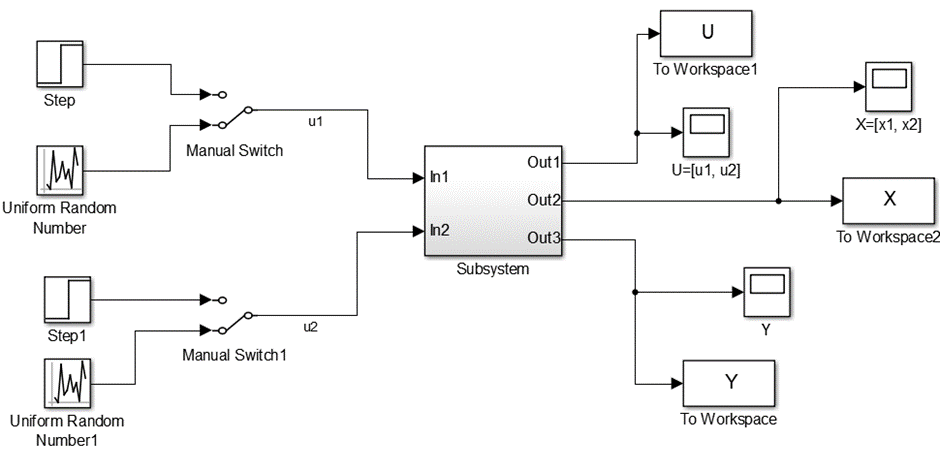Objectives
- To develop artificial neural network (ANN) models using the MATLAB Neural Net Fitting Toolbox.
- To implement ANN models as soft sensors in Simulink and evaluate their predictive performance.
Problem Statement
In a distillation column, the distillate product impurity (percentage impurity) is strongly influenced by the column tray temperature and the column differential pressure. Figure 1 shows a Simulink representation of the column, where:

The dynamics of the intermediate variables are given by the following transfer functions:
For tray temperature (
For differential pressure (
The relation between impurity and process variables is nonlinear:
You wish to develop an ANN model to predict the distillate impurity
For training, use data generated by applying a uniform random number generator (sampling time = 1 unit) to the inputs
Methodology
- ANN Model Development
- Generate datasets using random inputs for
- Train two ANN models using the Neural Net Fitting Toolbox:
- ANN 1: trained on 100 units of data
- ANN 2: trained on 200 units of data
- ANN 1: trained on 100 units of data
- Vary the number of hidden layers and neurons to find the best model structure.
- Report regression performance (R²), training error, and regression plots.
- Generate datasets using random inputs for
- Implementation in Simulink
- Integrate the trained ANN models into the provided Simulink model of the distillation column.
- Apply the step-change sequence to
- Compare ANN-predicted impurity against the actual nonlinear relation (Eq.
- Integrate the trained ANN models into the provided Simulink model of the distillation column.
- Evaluation
- Assess accuracy of ANN 1 vs ANN 2 based on:
- Regression performance (R² values)
- Fit of ANN outputs vs actual impurity under step disturbances
- Regression performance (R² values)
- Comment on the impact of training data size on prediction capability.
- Assess accuracy of ANN 1 vs ANN 2 based on:
Report Format
Your report (5 pages maximum) should include the following:
Submission Details Include a brief table at the beginning of the report with the following information:
Lab Title: Lab 05 - Artificial Neural Networks Student Name ID Unit: CHEN4011 Student 1 12345678 Date: 12 August 2025 Student 2 87654321 Objective & Problem Statement Summarize the purpose of ANN modeling and the context of impurity prediction in distillation.
Methodology & Implementation
- Describe ANN training procedure (datasets, hidden layers, toolbox functions).
- Show regression plots for ANN 1 and ANN 2.
- Report number of hidden layers and R² values.
- Provide Simulink diagrams used for testing.
- Results
- Show simulated responses of predicted impurity vs actual impurity under the defined step-change inputs.
- Present results for both ANN 1 and ANN 2.
- Highlight key differences in prediction accuracy.
- Analysis and Discussion
- Compare performance of ANN 1 and ANN 2.
- Discuss how dataset length and ANN architecture affect prediction accuracy.
- Comment on limitations of using ANN as soft sensors in nonlinear systems.
- Conclusion
- Summarize findings on ANN prediction accuracy.
- State which ANN performed best and why.
- Discuss broader applications of ANN-based soft sensors in process systems.
Assessment Rubric (20 Marks Total)
| No | Section | Marks | Evaluation basis |
|---|---|---|---|
| 1. | Objectives & Problem | 2 | Clarity of problem definition; articulation of objectives |
| 2. | Methodology and Implementation | 6 | ANN training details; Simulink integration; regression plots and R² reporting |
| 3. | Results | 4 | Quality, relevance, and labeling of plots; comparison of ANN 1 vs ANN 2 outputs |
| 4. | Analysis and Discussion | 6 | Insightful interpretation; effect of training size and architecture; limitations |
| 5. | Conclusion and Presentation | 2 | Coherent summary; quality of writing, formatting, and visual presentation |
Citation
@online{utikar2023,
author = {Utikar, Ranjeet},
title = {Lab 05: {Artificial} {Neural} {Networks}},
date = {2023-09-10},
url = {https://amc.smilelab.dev/content/labs/lab-05/},
langid = {en}
}